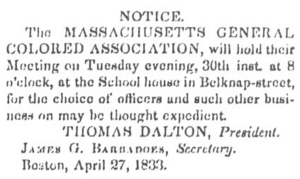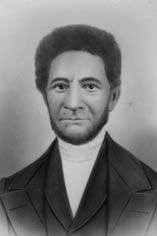John T. Hilton facts for kids
John Telemachus Hilton (born April 1801 – died March 5, 1864) was an important African-American leader. He worked as an abolitionist, fighting to end slavery. He was also an author and a successful businessman.
Hilton owned several businesses, including a barber shop, a furniture store, and an employment agency. He was a key figure in the Prince Hall Masonic group. He even started the Prince Hall National Grand Lodge of North America and was its first leader for ten years. John T. Hilton also helped create the Massachusetts General Colored Association. He was very active in the Anti-Slavery movement, writing and speaking out against slavery.
Both John T. Hilton and his wife, Lavinia Hilton, were deeply involved in the Anti-Slavery and Temperance movements.
Contents
John T. Hilton's Early Life and Business
John Telemachus Hilton was born in 1801 in Chester County, Pennsylvania. When he was 17, Hilton moved to Boston. On April 1, 1825, he married Lavinia M. Ames in Boston. They had five children together, three sons and two daughters.
By 1830, John T. Hilton had opened his own hairdressing shop. This store was more than just a barber shop. It also served as his employment agency, sold various retail items, and even sold furniture on commission. He also sold tickets for local events.
Hilton's Role as a Freemason Leader
On June 24, 1847, John T. Hilton played a big part in organizing the National Grand Lodge of Prince Hall Freemasonry. He became its very first National Grand Master. Hilton led the National Grand Lodge of North America for a decade. To honor his work, a lodge in Lynn, Massachusetts was named the John T. Hilton Lodge.
He was the first African-American man in Boston to have his picture painted for a Prince Hall Masonic Lodge.
Fighting for Freedom: Anti-Slavery Work
Hilton wrote an important speech called An Address, Delivered Before the African Grand Lodge of Boston, No. 459, June 24, 1828. This speech was published with help from other famous abolitionists, Thomas Dalton (abolitionist) and David Walker (abolitionist).
Massachusetts General Colored Association

Hilton and other Prince Hall Freemasons were among the first members of the Massachusetts General Colored Association. This group was known for having "the most spirited and intelligent colored citizens of Boston" as its leaders. They worked together to fight for the rights of African Americans.
Anti-Slavery Society Involvement
In 1854, Hilton became the vice-president of the Massachusetts Anti-Slavery Society. This society was dedicated to ending slavery in the United States. He was also a member of the Boston Vigilance Committee. This committee helped enslaved people escape to freedom.
Hilton's wife, Lavinia, was also a strong activist. She was known as one of the "young intellectuals and active abolitionists" in the 1830s. Lavinia Hilton was a member of the Boston Female Anti-Slavery Society, working alongside women like Susan Paul.
Leading the Temperance Movement
By 1838, Hilton was the president of the New England Temperance Society of Colored Americans. This group worked to encourage people to avoid alcohol. His wife, Lavinia, was the treasurer of the women's branch of this society.
Hilton's Family and Home Life
Hilton and his wife, Lavinia, were both members of the African Baptist Church. Mrs. Hilton was also a member of the female Anti-Slavery Society. From 1848 to 1851, Hilton lived at 3 Second Street in Boston and continued to work as a barber.
Their oldest daughter, Lucretia L. Hilton, went to special schools in Beacon Hill and Cambridge. Lucretia helped her father in his anti-slavery efforts. She handed out flyers for the Boston Vigilance Committee. Lucretia married John M. Lenox and moved to Waltham, Massachusetts. They both worked hard to reduce prejudice and increase anti-slavery feelings in their new town.
Lavinia Ames Hilton's ancestor, Prince Ames, was a soldier in the American Revolutionary War. He fought bravely at the Battle of Bunker Hill.
John T. Hilton's Death
John T. Hilton passed away on March 5, 1864, in Brighton, Massachusetts. He was 62 years old and died from a liver condition. His wife, Lavinia, died later on November 2, 1882, in Cambridge, Massachusetts.


